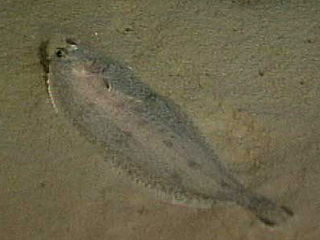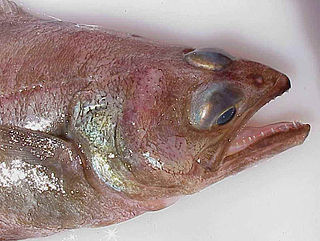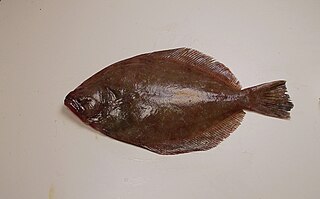
Flounders are a group of flatfish species. They are demersal fish, found at the bottom of oceans around the world; some species will also enter estuaries.

Herring are forage fish, mostly belonging to the family of Clupeidae.

The California halibut or California flounder is a large-tooth flounder native to the waters of the Pacific Coast of North America from the Quillayute River in Washington to Magdalena Bay in Baja California. It feeds near shore and is free swimming. It typically weighs 6 to 30 pounds. It is much smaller than the larger and more northern-ranging Pacific halibut that can reach 300 pounds (140 kg).

The black flounder, also known by the Māori language name mohoao, is a flatfish of the genus Rhombosolea, found around New Zealand in shallow enclosed waters and coastal freshwater lakes. Its adult length ranges from 20 to 45 cm.

The starry flounder, also known as the grindstone, emery wheel and long-nosed flounder, is a common flatfish found around the margins of the North Pacific.
Gastropsetta frontalis, the shrimp flounder, is a species of large-tooth flounder, the only member of its genus Gastropsetta. It is endemic to the western Atlantic Ocean, from North Carolina to Florida, and from the northern Gulf of Mexico to Panama. It also occurs in The Bahamas.

Paralichthys adspersus, the fine flounder, is a species of large-tooth flounder native to the eastern Pacific Ocean, along the continental shelf from the coast of Ecuador in the north to the coast of Peru in the south.

The witch, known in English by a variety of other common names including the witch flounder, pole flounder, craig fluke, Torbay sole, and grey sole, is a species of flatfish from the family Pleuronectidae. It occurs on both sides of the North Atlantic Ocean on muddy sea beds in quite deep water. In northern Europe it has some importance in fisheries as a food fish.

The arrowtooth flounder is a fish in the family Pleuronectidae. It can be caught from the Bering Sea to Santa Rosa Island, California. At present, it is the most common fish in the Gulf of Alaska. Data is insufficient for many of the flounder's general traits, including size and age of sexual maturity. Spawning is known to occur from December through February and the species can live up to 27 years.

The leopard flounder or panther flounder, is a flatfish found in the Pacific and Indian Oceans.

The yellowtail flounder, also known as the rusty dab, is a species of flatfish in the family Pleuronectidae. Reaching 56 cm (22 in) in length, it has reddish brown upperparts, pale underparts and yellow fins. Both its eyes are on the right (upper) side of its body. Found in the western North Atlantic, it has been fished commercially by North American fisheries for food. A victim of overfishing, the yellowtail flounder is categorized as "Vulnerable" by the International Union for Conservation of Nature.

The European flounder is a flatfish of European coastal waters from the White Sea in the north to the Mediterranean and the Black Sea in the south. It has been introduced into the United States and Canada accidentally through transport in ballast water. It is caught and used for human consumption.

Paralichthys lethostigma, the southern flounder, is a species of large-tooth flounder native to the East Coast of the United States and the northern Gulf of Mexico. It is a popular sport fish and is the largest and most commercially valuable flounder in the western North Atlantic Ocean and Gulf of Mexico. It is a "left-eyed flounder", meaning the left side is pigmented and is the "up side".

Glyptocephalus is a genus of righteye flounders found in the North Atlantic and North Pacific Oceans

The blackfin flounder is a flatfish of the family Pleuronectidae. It is a demersal fish that lives in temperate waters at depths of between 8 and 1,600 metres, though it is most commonly found between 15 and 800 metres. Its native habitat is the northern Pacific, from the Sea of Japan to the Strait of Tartary and southern Kuril Islands and out into the Bering Sea. It grows up to 52 centimetres (20 in) in length, and can weigh up to 1.5 kilograms (3.3 lb). Maximum reported lifespan is 23 years.

Ancylopsetta dilecta, the three-eye flounder, is a species of large-tooth flounder found along the Atlantic and Caribbean coasts of North and Central America. It is found down to depths of 137 m (449 ft). This species grows to 25 cm (9.8 in) in total length.

The rex sole is a flatfish of the family Pleuronectidae. Locally, it may also be known as a witch or threadfin sole. It is a demersal fish that lives in temperate waters on sand or mud bottoms at depths of up to 900 metres (3,000 ft), though it is most commonly found between 61 and 500 metres. Its native habitat is the northern Pacific, from Baja California in Mexico up the coasts of the United States, British Columbia and Alaska, across the Bering Sea to the coast of Russia and the Sea of Japan. It is slow-growing, reaching up to 60 centimetres (24 in) in length, and it can weigh up to 2.0 kilograms (4.4 lb). Maximum reported lifespan is 24 years.

The peacock flounder, also known as the flowery flounder, is a species of fish in the family Bothidae. The species is found widely in relatively shallow waters in the Indo-Pacific, also ranging into warmer parts of the East Pacific.
Citharichthys abbotti, the Veracruz whiff, is a species of flatfish in the large-tooth flounder family Paralichthyidae. It is endemic to the southwestern Gulf of Mexico, found on the Eastern Mexico Continental Shelf, with Veracruz to the south and the Rio Grande to the north.

Citharus linguatula, the spotted flounder or Atlantic spotted flounder, is a species of fish in the Citharidae, a family of flounders. It is native to the eastern Atlantic Ocean and the Mediterranean Sea, where it is found to a depth of 300 m (980 ft). This species grows to a total length of 30 cm (12 in). It is of minor importance to local commercial fisheries. This species is the only known member of its monotypic genus.



















